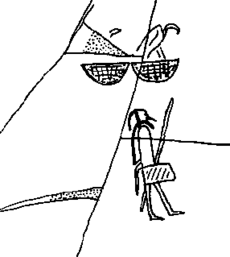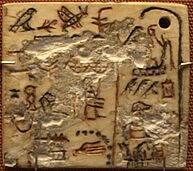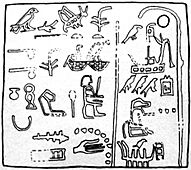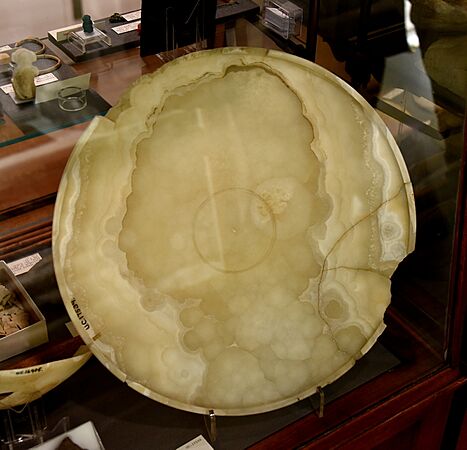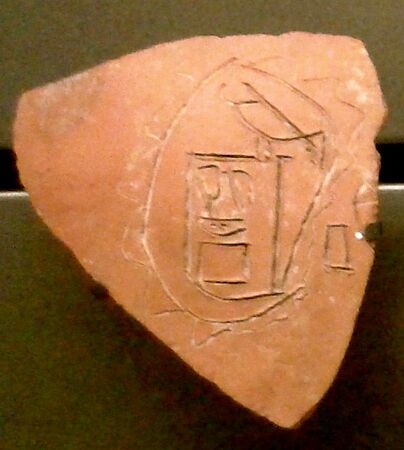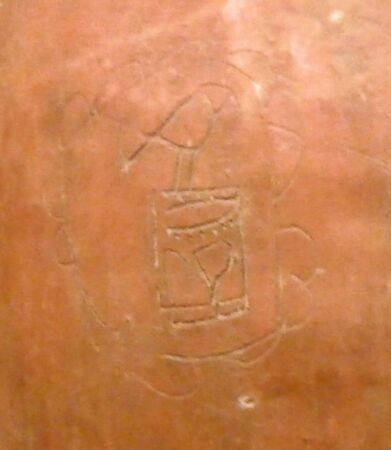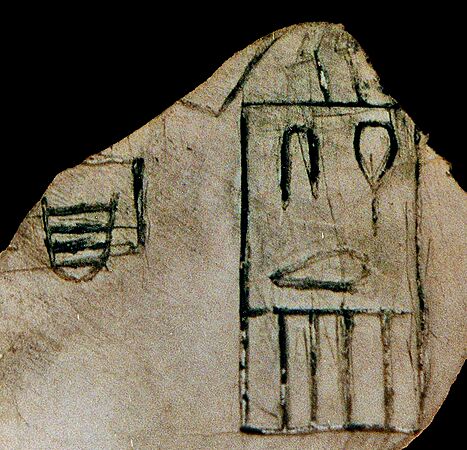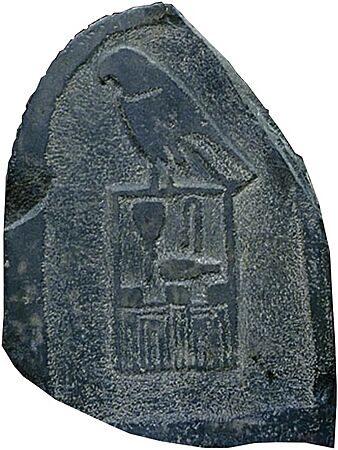Semerkhet facts for kids
Quick facts for kids Semerkhet |
|
|---|---|
| Semempses, Mempses | |
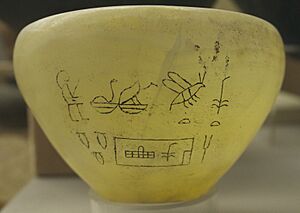
Alabaster vase of Semerkhet, the inscription reads King Iry-Nebty visits the house-of-the-pleased-king, oil jars for it, National Archaeological Museum (France)
|
|
| Pharaoh | |
| Reign | 8½ years, ca. 2920 BC (First Dynasty) |
| Predecessor | Anedjib |
| Successor | Qa'a |
| Father | Anedjib ? Den ? |
| Mother | Betrest |
| Burial | Tomb U, Umm el-Qa'ab |
Semerkhet was an early Egyptian pharaoh from the First Dynasty. His name is known as a Horus name, which was a special title for kings. Ancient stories, like those from the historian Manetho, say that something bad happened during Semerkhet's rule. Old records found by archaeologists seem to agree that he had a tough time as king. Some early experts even wondered if he was the rightful ruler.
Contents
How Long Did Semerkhet Rule?
Manetho, an ancient historian, said Semerkhet ruled for 18 years. Another old record, the Royal Canon of Turin, claimed he ruled for an unbelievable 72 years! However, modern Egyptologists and historians believe both these numbers are too high. They think Semerkhet ruled for about 8 and a half years. This idea comes from the Cairo Stone, an ancient stone that lists the reigns of pharaohs. The short reign is also supported by what archaeologists have found.
Understanding Semerkhet's Names
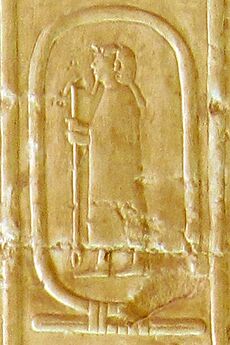
We know a lot about Semerkhet from ancient objects. His name is carved on bowls made of stone like schist and alabaster. It's also found on small ivory tags and seals used on clay jars. These items were found in important ancient cities like Abydos and Sakkara.
Semerkhet's serekh name is often translated as "companion of the divine community" or "thoughtful friend." The second meaning is debated because the hieroglyph khet usually means "body" or "divine community."
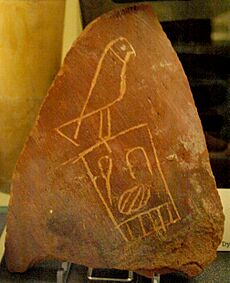
His birth name is a bit harder to understand. The symbol used for it is a walking man with a cloak and a stick. This symbol is very rare and only appears with Semerkhet. Experts like Toby Wilkinson think it means "divine guardian."
Semerkhet was the first king to use the Nebty title in its full form. This title refers to the "Two Ladies," the goddesses Nekhbet and Wadjet. These goddesses were protectors of Lower Egypt and Upper Egypt. By using this title, Semerkhet showed his connection to the unified land. His full royal name, Nisut-Bity-Nebty-Iry, means "King of Upper and Lower Egypt, he of the two ladies, and he who belongs to them."
Later scribes, during the time of Ramesses II, were confused by Semerkhet's old hieroglyph. It looked like the symbol for an old man, which meant "the eldest." Because of this confusion, different king lists wrote his name differently. The Abydos King List tried to copy the original symbol, while the Royal Canon of Turin wrote it as "Semsem." The Saqqara King List doesn't even include his throne name.
Semerkhet's Family
We don't know much about Semerkhet's family. His parents are not clearly known, but some think his father might have been King Den. Queen Betrest is mentioned on the Cairo Stone as his mother, but this isn't fully proven. We also don't know the names of any of his children. His successor, King Qa'a, is a possible family member.
Events During Semerkhet's Rule
Some historians once believed Semerkhet was a "usurper," meaning he took the throne illegally. They thought this because some stone vessels with Semerkhet's name originally had King Adjib's name on them. It looked like Semerkhet just erased Adjib's name and put his own. Also, no tombs of high officials linked to Semerkhet were found in Sakkara, unlike other kings.
However, this idea is not widely supported today. Many Egyptologists believe Semerkhet was a rightful king. They point out that his name appears with other kings like Den and Qa'a on vessels found in the Pyramid of Djoser at Saqqara. This shows that King Qa'a, who came after Semerkhet, saw him as a proper ancestor. Also, it was common for kings to take special "anniversary vessels" from their predecessor's tombs and put their own names on them. The lack of official tombs might just be because Semerkhet's reign was short.
Records from Semerkhet's burial site show new royal areas and a "house of the harem" for his wives. Ivory tags describe yearly events like the "Escort of Horus," which was related to collecting taxes. Other tags mention celebrations for ancient gods and a special "Sokar" festival.
The Cairo Stone records events from Semerkhet's entire reign, but much of it is hard to read now. Here are some of the events that can still be seen:
- Year of becoming king: The king of Upper and Lower Egypt appeared; the two lands were united; a ceremony around the White Wall of Memphis took place.
- First year: Escort of Horus; destruction of Egypt
- Second year: The king appeared; a statue for the goddess Seshat was made.
- Third year: Escort of... (the rest is missing)
- Fourth year: The king of Upper Egypt appeared; creation of... (the rest is missing)
- Fifth year: Escort of... (the rest is missing)
- Sixth year: The king of Upper Egypt appeared... (the rest is missing)
- Seventh year: Escort of... (the rest is missing)
- Eighth year: The king of Lower and Upper Egypt appeared... (the rest is missing)
- Year of death: The month and day are damaged.
Experts are very interested in the phrase "Destruction of Egypt" from his first year. The stone doesn't give more details, but it sounds like Manetho's report. Manetho wrote that a "very great calamity" or "many portents and a great pestilence" happened during Semerkhet's rule. No other ancient documents explain what this "calamity" was.
Semerkhet's Tomb
Semerkhet's tomb, called "Tomb U," was excavated in 1899 by archaeologist Sir William Matthew Flinders Petrie in Abydos. Unlike other tombs, it didn't have stairs. Instead, it had a wide ramp leading straight into the main room. The ramp was covered in a thick layer of fragrant oil, which still smelled good when found. Near the ramp, wooden baskets and clay jars from the time of Ramesses II were discovered. This suggests Semerkhet's tomb was reopened and restored much later.
Inside the main room, valuable items were found, like parts of furniture, copper tools, and jewelry made of ebony, amethyst, and turquoise. Some vessels from the Levant (a region in the Middle East) were also found. These once held a valuable oil called Bescha. Outside the tomb, a damaged stone slab with Semerkhet's name was found.
The burial room itself is large, measuring about 29 by 20 meters, and is simply built. Petrie noticed that the king's main tomb once covered many smaller "subsidiary tombs." These 67 smaller tombs were part of the royal burial site. Egyptologists believe this shows that the royal family and servants were willingly killed and buried with the king when he died. This practice of burying people with the king was stopped during the reign of King Qaa, who was one of the last rulers of the First Dynasty. Tombs from the Second Dynasty onwards, like that of Hotepsekhemwy, do not have these subsidiary tombs.
Images for kids
-
Pottery shard bearing Semerkhet's serekh, on display at the Musée du Louvre
-
Clay jar incised with Semerkhet's serekh, Musée du Louvre
-
Fragment of a vessel of white marble bearing the serekh of Semerkhet, at the left of the serekh a per bja, meaning "brazen house" or "house of ore", is mentioned, Egyptian Museum, Cairo


